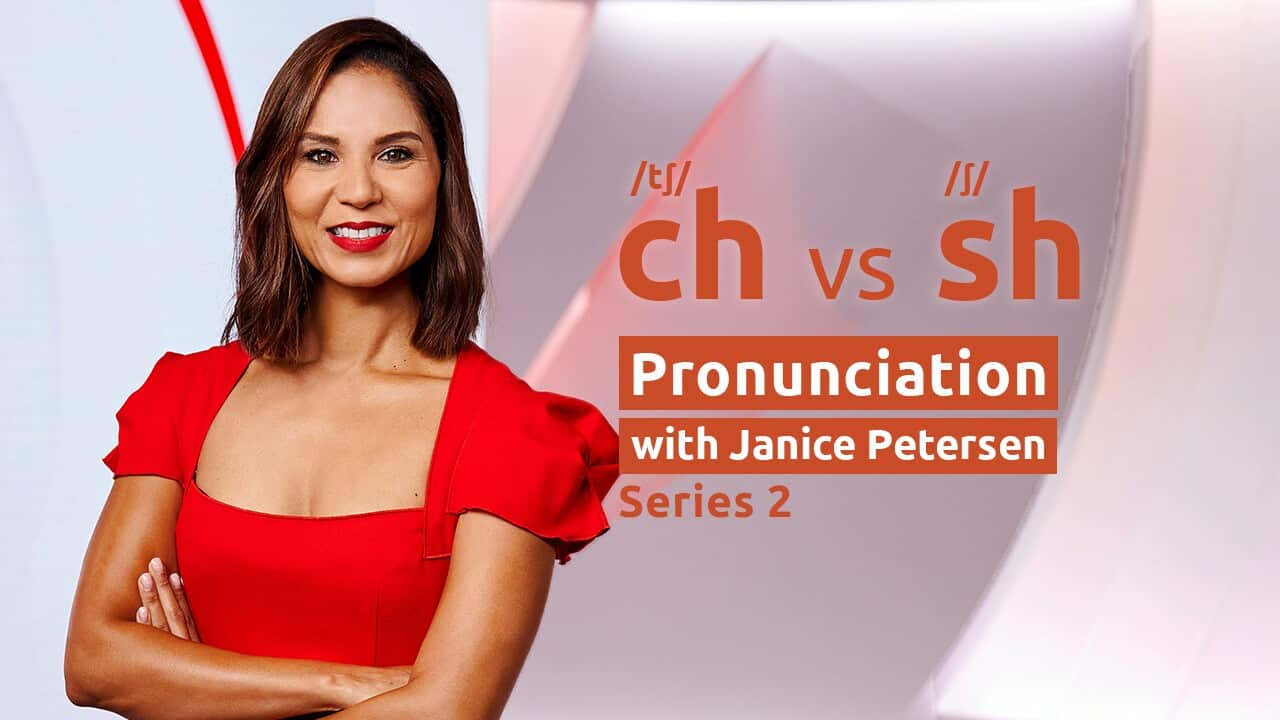Key Points
- Learning objectives: Can pronounce /tʃ / and /ʃ/ (ch and sh)
- First language influence: /ʃ/ vs /tʃ/ is a systematic pronunciation error common amongst many learners, and is especially difficult for Thai, Vietnamese, Cantonese, Japanese, Mandarin, Hindi, and Greek speakers. /ʃ/ and /tʃ/ do not exist in Indonesian and Khmer.
- Text for practise: If a dog chews shoes, whose shoes does he choose?
- Minimal Pairs: /tʃ/ chew, chip, chop, cheap, chin /ʃ/ shoe, ship, shop, sheep, shin
This lesson suits all learners at all levels.
Check out the rest of Season 2

Improve your pronunciation | Season 2
If you missed the first season of our popular podcast, now's your chance to catch up!

Improve your pronunciation | Season 1
Transcript:
(Note: This is not a word-for-word transcript)
If a dog chews shoes, whose shoes does he choose?
Sometimes I wish animals could talk so we could ask them questions like this!
Hi, I’m Janice Petersen from SBS World News and this lesson will help you improve your pronunciation so you can feel confident talking to people.
Maybe not animals… but today we don’t have to worry about our pets. We are going to learn about the /ʃ/ [sshhh] sound in shoes and the /tʃ/ [ch] sound in chews.
Sometimes it can be hard to tell the difference between the two sounds, but don’t worry, we’re going to work on it together.
Let’s start by comparing these sounds using some words you hear every day. The /ʃ/ sound in shoes can be heard in ship, shop, sheep and shin.
When you add a /t/ [te] sound to the start of the /ʃ/ [ssshhh] sound, you get /tʃ/ [ch] in chew, chip, chop, cheap, and chin.
These sounds take practise to pronounce because they are so similar and also because they are both made by lightly putting your teeth together with the sides of your tongue against your back teeth.
Pretend to tell someone to be quiet and push air along your tongue towards the sharp edge of your front teeth so that the air leaves your mouth: shhhh.
Try repeating the words with the /ʃ/ sound with me:
- Shoe
- Ship
- Shop
We’re making some good progress. Now, to make the /tʃ/ sound in chews. Push the air along your tongue, but don’t release it from your mouth: ch chews, ch chews. Let’s try saying it together with these words:
- Chew
- Chip
- Chop
You might have noticed that both the /ʃ/ and /tʃ/ sounds are unvoiced. This means there will be no vibrations if you put your hand on your neck when you say them.
I think we’re ready! Let’s try these sounds out in the tongue twister:
If a dog chews shoes, whose shoes does he choose?
Who’s ready to give it a go?
Students
We are students from Catholic Care Victoria.
Ok, learners from Catholic Care Victoria , let me hear you...
Students
If a dog chews shoes, whose shoes does he choose?
Our tongues got twisted on that one!
Think about trying it out next time you see a dog. Maybe they understand more than they let us know!
CREDITS
Thanks to our educational consultant, Natalie Oostergo from IES College and learners from .
瀏覽更多最新時事資訊,請登上、、,或訂閱。
SBS 中文堅守,以繁體中文及簡體中文提供公平、公正、準確的新聞報道及時事資訊。SBS 廣東話及 SBS 普通話均已為大眾服務超過 40 年。歡迎在每天早上 9 至 11 時透過收聽廣東話節目及在每天早上 7 至 9 時收聽普通話節目,或透過收聽直播、節目重溫及其他語音內容。




